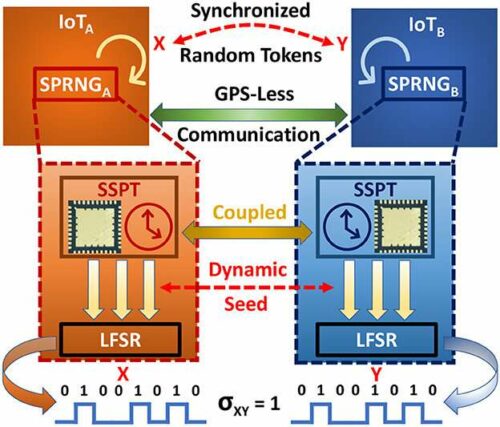Researchers have developed a concept of GPS-free secure communication in spatially separated IoTs with synchronized pseudo-random-number generator (SPRNG).

Information is a key, and with wearable fitness trackers, car key fobs and smart home devices, the Internet of Things (IoT) has become ubiquitous in our lives. Unfortunately, much of this flow of information is vulnerable to malicious activity and attacks, as securing the IoT has not kept pace with new technological advances.
Researchers from Washington University in St. Louis has developed a prototype method to better secure these communications using a synchronized pseudo-random-number generator (SPRNG). Securing wireless communications in IoT requires generation and synchronization of random numbers in real time—encrypting the data using a sequence of random numbers produced by a generator, then synchronizing them using a timing reference extracted from a global positioning system (GPS). For devices that operate on batteries or in energy-constrained resources, this is not practical, as many IoT devices do not have access to a GPS signal.
Professor Shantanu Chakrabartty, from Preston M. Green Department of Electrical & Systems Engineering at Washington University in St. Louis, and Mustafizur Rahman, a doctoral student in his lab, created a prototype synchronized self-powered timer array using quantum-mechanical tunneling of electrons that is secure against tampering, snooping and side-channel attacks.
They specifically used Fowler-Nordheim (FN) quantum tunneling, in which electrons jump through a triangular barrier, and in the process, change the shape of the barrier. FN tunneling provides a much simpler and more energy-efficient connection than existing methods that are too complex for computer modeling, and because it is self-powered, it is secure against attacks.
Researchers believe that the proposed SPRNG method could be used as a trusted platform module on the Internet of Things and used to verify and authenticate secure transactions, such as software upgrades. “Since this system does not require access to GPS for synchronization, it could be used in resource-constrained and adversarial environments, including health care and military IoTs,” he said.
Reference : Mustafizur Rahman et al, GPS-free synchronized pseudo-random number generators for internet-of-things, Frontiers in Computer Science (2023). DOI: 10.3389/fcomp.2023.1157629








Hii
Hi, how can I help you?
Does that mean the information firewall of the Internet of Things?
This system cannot be considered to be a firewall, as a firewall acts a layer over the complete data that prohibits any hacker to pass ahead….Whereas this is a part of the data itself, it’s like a new bit in the data architecture.
Thanks for your help.
Thanks for your help.